An Analysis of Mobile Phone Usage Among University Students
VerifiedAdded on 2023/04/08
|5
|1063
|112
Report
AI Summary
This report examines the increasing mobile phone usage among youth, particularly university students, and its impact on their lives. The study, conducted on a sample of 30 students from three Australian universities, explores the frequency and influence of mobile phone use. The research investigates whether mobile phones are beneficial tools or a major distraction for students. The findings reveal that affordability, need, and convenience have contributed to the rise in mobile phone usage. The report also highlights the role of mobile phones in communication, social interaction, and overcoming feelings of loneliness. The study concludes that increased mobile phone usage has transformed society into a networked one, significantly impacting peer groups and individual identities. The references include key research papers on mobile phone usage and its effects on youth and academic performance.
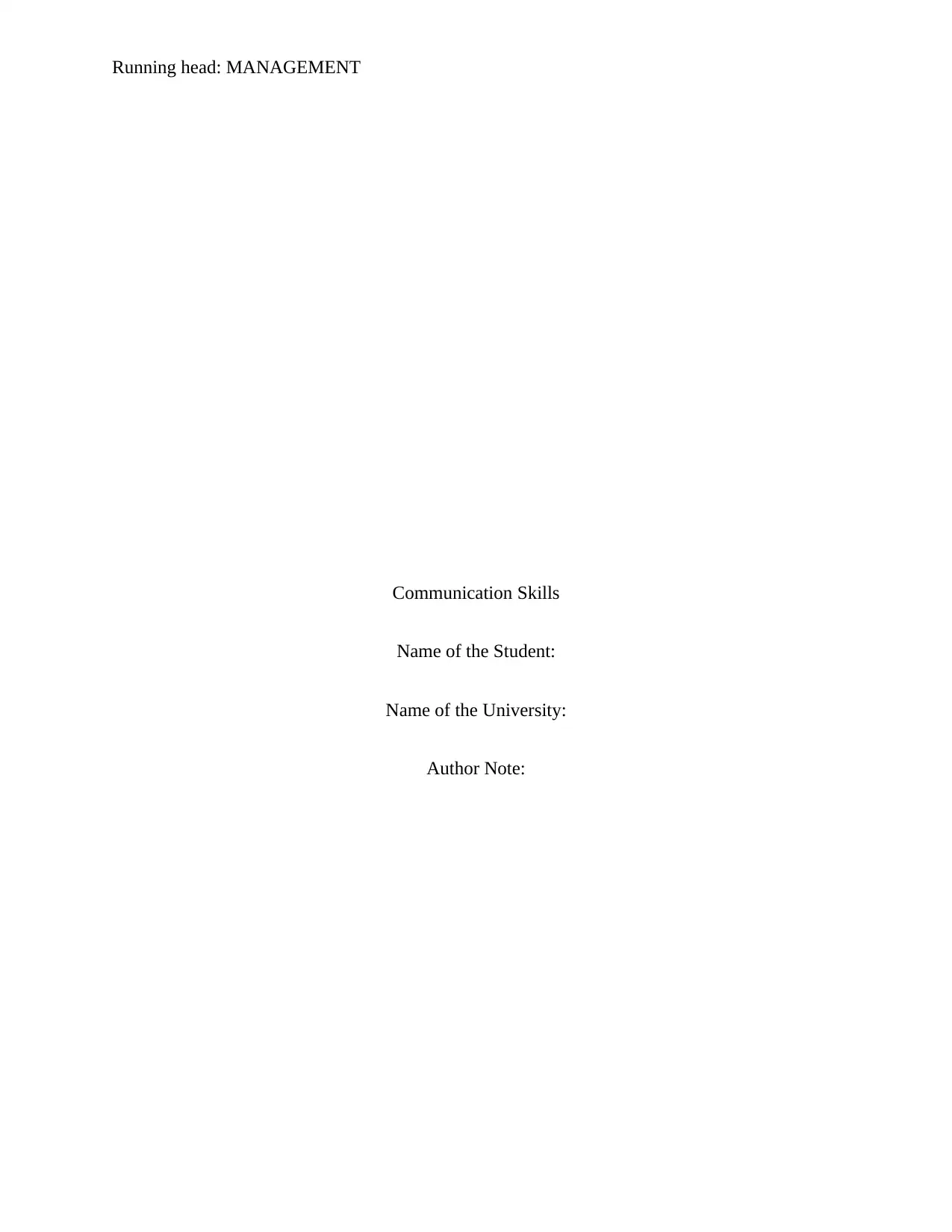
Running head: MANAGEMENT
Communication Skills
Name of the Student:
Name of the University:
Author Note:
Communication Skills
Name of the Student:
Name of the University:
Author Note:
Paraphrase This Document
Need a fresh take? Get an instant paraphrase of this document with our AI Paraphraser
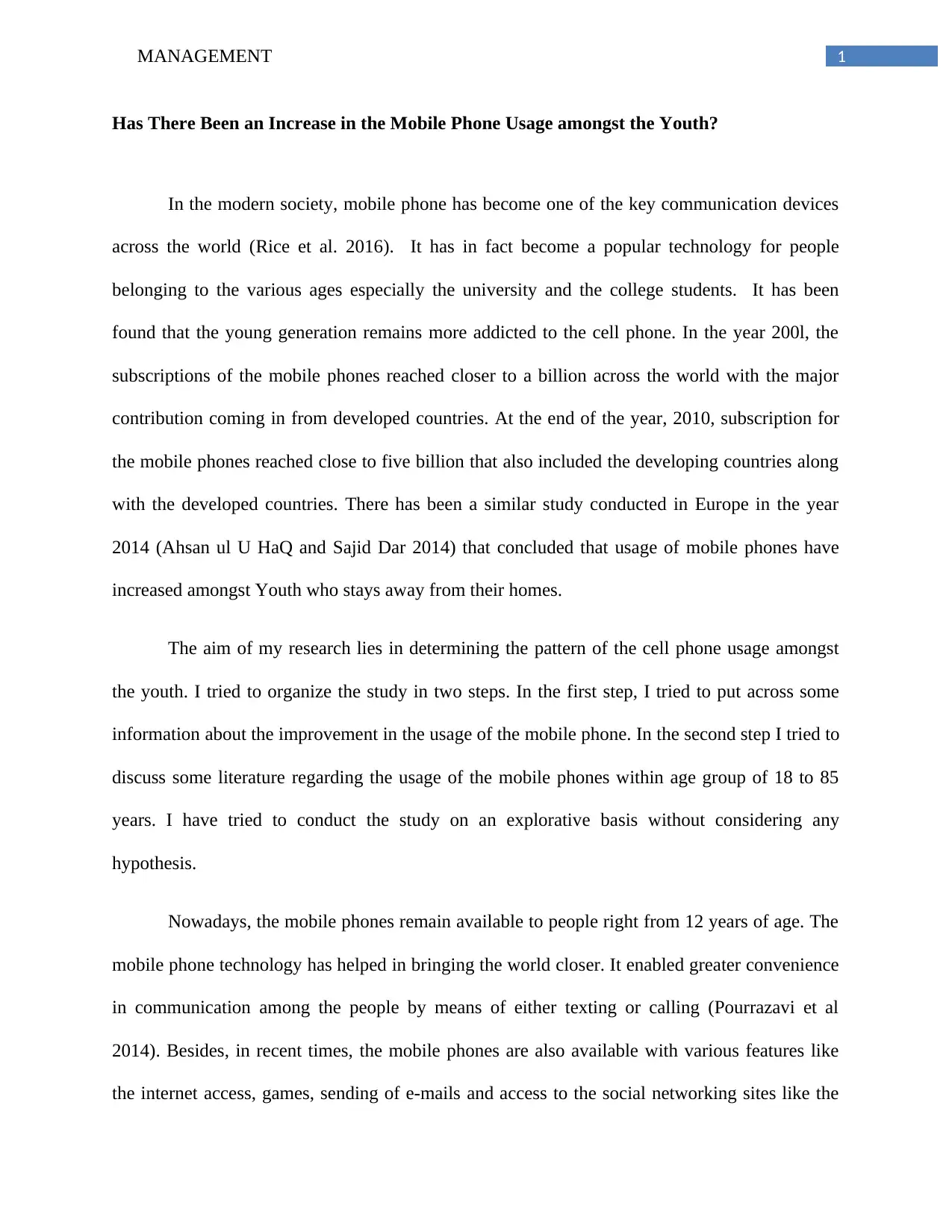
1MANAGEMENT
Has There Been an Increase in the Mobile Phone Usage amongst the Youth?
In the modern society, mobile phone has become one of the key communication devices
across the world (Rice et al. 2016). It has in fact become a popular technology for people
belonging to the various ages especially the university and the college students. It has been
found that the young generation remains more addicted to the cell phone. In the year 200l, the
subscriptions of the mobile phones reached closer to a billion across the world with the major
contribution coming in from developed countries. At the end of the year, 2010, subscription for
the mobile phones reached close to five billion that also included the developing countries along
with the developed countries. There has been a similar study conducted in Europe in the year
2014 (Ahsan ul U HaQ and Sajid Dar 2014) that concluded that usage of mobile phones have
increased amongst Youth who stays away from their homes.
The aim of my research lies in determining the pattern of the cell phone usage amongst
the youth. I tried to organize the study in two steps. In the first step, I tried to put across some
information about the improvement in the usage of the mobile phone. In the second step I tried to
discuss some literature regarding the usage of the mobile phones within age group of 18 to 85
years. I have tried to conduct the study on an explorative basis without considering any
hypothesis.
Nowadays, the mobile phones remain available to people right from 12 years of age. The
mobile phone technology has helped in bringing the world closer. It enabled greater convenience
in communication among the people by means of either texting or calling (Pourrazavi et al
2014). Besides, in recent times, the mobile phones are also available with various features like
the internet access, games, sending of e-mails and access to the social networking sites like the
Has There Been an Increase in the Mobile Phone Usage amongst the Youth?
In the modern society, mobile phone has become one of the key communication devices
across the world (Rice et al. 2016). It has in fact become a popular technology for people
belonging to the various ages especially the university and the college students. It has been
found that the young generation remains more addicted to the cell phone. In the year 200l, the
subscriptions of the mobile phones reached closer to a billion across the world with the major
contribution coming in from developed countries. At the end of the year, 2010, subscription for
the mobile phones reached close to five billion that also included the developing countries along
with the developed countries. There has been a similar study conducted in Europe in the year
2014 (Ahsan ul U HaQ and Sajid Dar 2014) that concluded that usage of mobile phones have
increased amongst Youth who stays away from their homes.
The aim of my research lies in determining the pattern of the cell phone usage amongst
the youth. I tried to organize the study in two steps. In the first step, I tried to put across some
information about the improvement in the usage of the mobile phone. In the second step I tried to
discuss some literature regarding the usage of the mobile phones within age group of 18 to 85
years. I have tried to conduct the study on an explorative basis without considering any
hypothesis.
Nowadays, the mobile phones remain available to people right from 12 years of age. The
mobile phone technology has helped in bringing the world closer. It enabled greater convenience
in communication among the people by means of either texting or calling (Pourrazavi et al
2014). Besides, in recent times, the mobile phones are also available with various features like
the internet access, games, sending of e-mails and access to the social networking sites like the
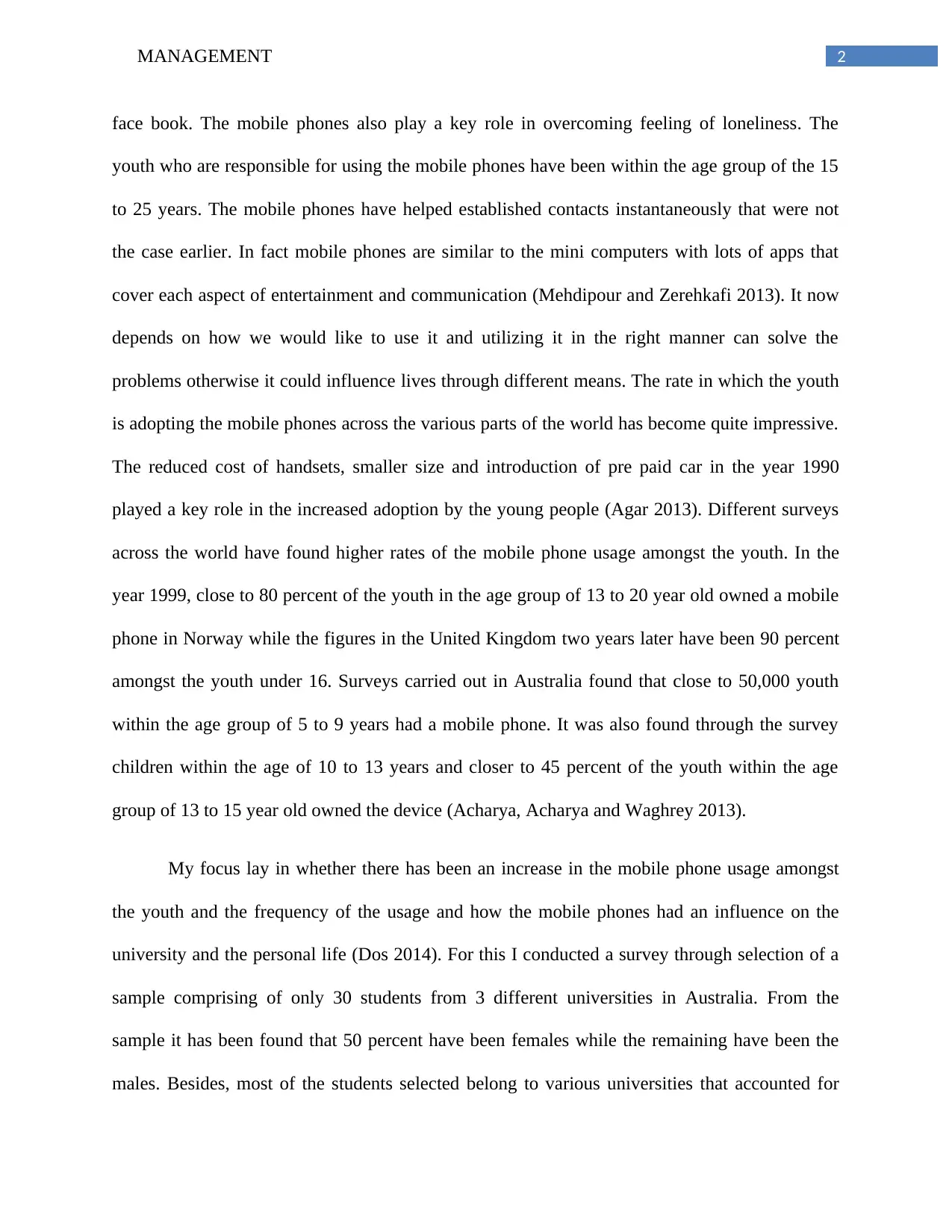
2MANAGEMENT
face book. The mobile phones also play a key role in overcoming feeling of loneliness. The
youth who are responsible for using the mobile phones have been within the age group of the 15
to 25 years. The mobile phones have helped established contacts instantaneously that were not
the case earlier. In fact mobile phones are similar to the mini computers with lots of apps that
cover each aspect of entertainment and communication (Mehdipour and Zerehkafi 2013). It now
depends on how we would like to use it and utilizing it in the right manner can solve the
problems otherwise it could influence lives through different means. The rate in which the youth
is adopting the mobile phones across the various parts of the world has become quite impressive.
The reduced cost of handsets, smaller size and introduction of pre paid car in the year 1990
played a key role in the increased adoption by the young people (Agar 2013). Different surveys
across the world have found higher rates of the mobile phone usage amongst the youth. In the
year 1999, close to 80 percent of the youth in the age group of 13 to 20 year old owned a mobile
phone in Norway while the figures in the United Kingdom two years later have been 90 percent
amongst the youth under 16. Surveys carried out in Australia found that close to 50,000 youth
within the age group of 5 to 9 years had a mobile phone. It was also found through the survey
children within the age of 10 to 13 years and closer to 45 percent of the youth within the age
group of 13 to 15 year old owned the device (Acharya, Acharya and Waghrey 2013).
My focus lay in whether there has been an increase in the mobile phone usage amongst
the youth and the frequency of the usage and how the mobile phones had an influence on the
university and the personal life (Dos 2014). For this I conducted a survey through selection of a
sample comprising of only 30 students from 3 different universities in Australia. From the
sample it has been found that 50 percent have been females while the remaining have been the
males. Besides, most of the students selected belong to various universities that accounted for
face book. The mobile phones also play a key role in overcoming feeling of loneliness. The
youth who are responsible for using the mobile phones have been within the age group of the 15
to 25 years. The mobile phones have helped established contacts instantaneously that were not
the case earlier. In fact mobile phones are similar to the mini computers with lots of apps that
cover each aspect of entertainment and communication (Mehdipour and Zerehkafi 2013). It now
depends on how we would like to use it and utilizing it in the right manner can solve the
problems otherwise it could influence lives through different means. The rate in which the youth
is adopting the mobile phones across the various parts of the world has become quite impressive.
The reduced cost of handsets, smaller size and introduction of pre paid car in the year 1990
played a key role in the increased adoption by the young people (Agar 2013). Different surveys
across the world have found higher rates of the mobile phone usage amongst the youth. In the
year 1999, close to 80 percent of the youth in the age group of 13 to 20 year old owned a mobile
phone in Norway while the figures in the United Kingdom two years later have been 90 percent
amongst the youth under 16. Surveys carried out in Australia found that close to 50,000 youth
within the age group of 5 to 9 years had a mobile phone. It was also found through the survey
children within the age of 10 to 13 years and closer to 45 percent of the youth within the age
group of 13 to 15 year old owned the device (Acharya, Acharya and Waghrey 2013).
My focus lay in whether there has been an increase in the mobile phone usage amongst
the youth and the frequency of the usage and how the mobile phones had an influence on the
university and the personal life (Dos 2014). For this I conducted a survey through selection of a
sample comprising of only 30 students from 3 different universities in Australia. From the
sample it has been found that 50 percent have been females while the remaining have been the
males. Besides, most of the students selected belong to various universities that accounted for
⊘ This is a preview!⊘
Do you want full access?
Subscribe today to unlock all pages.

Trusted by 1+ million students worldwide
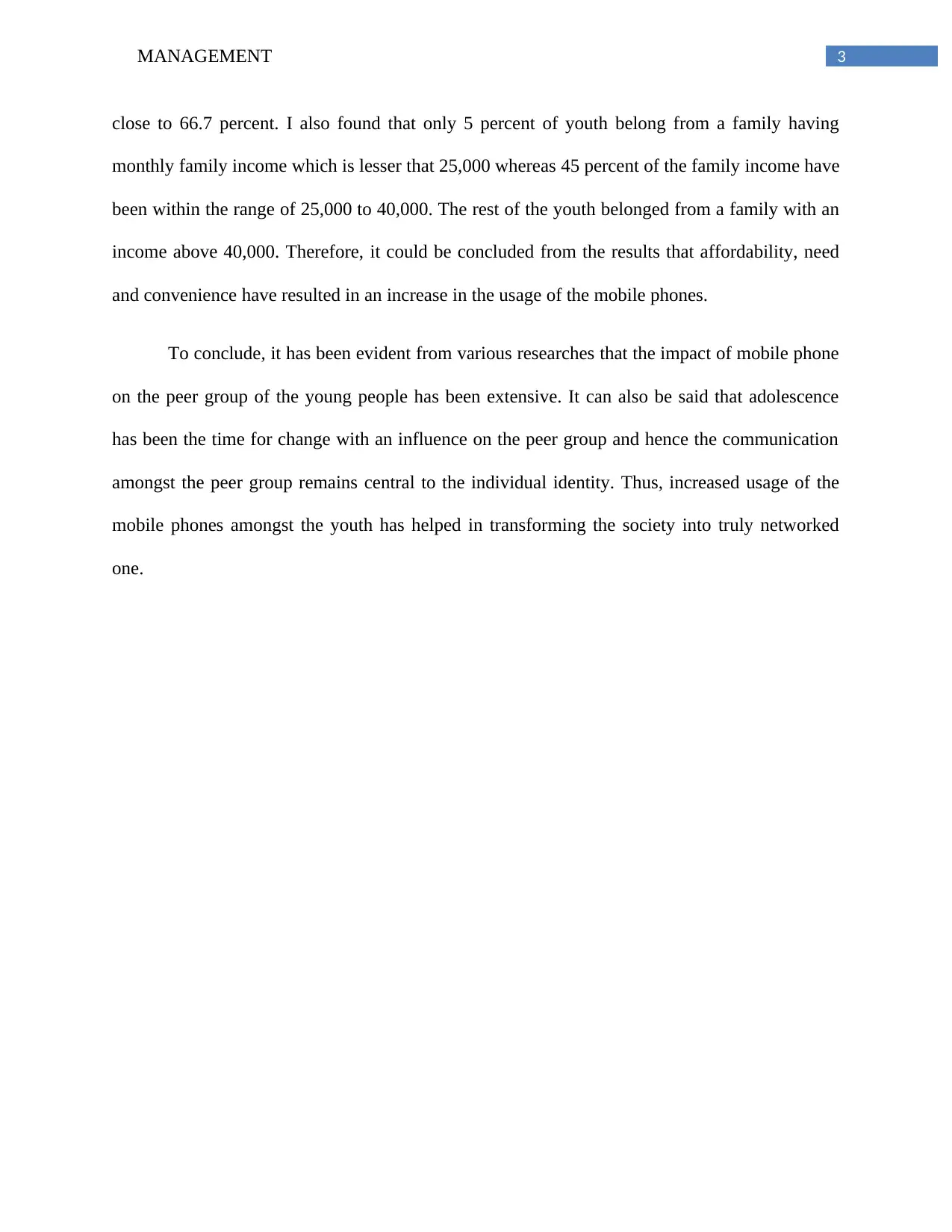
3MANAGEMENT
close to 66.7 percent. I also found that only 5 percent of youth belong from a family having
monthly family income which is lesser that 25,000 whereas 45 percent of the family income have
been within the range of 25,000 to 40,000. The rest of the youth belonged from a family with an
income above 40,000. Therefore, it could be concluded from the results that affordability, need
and convenience have resulted in an increase in the usage of the mobile phones.
To conclude, it has been evident from various researches that the impact of mobile phone
on the peer group of the young people has been extensive. It can also be said that adolescence
has been the time for change with an influence on the peer group and hence the communication
amongst the peer group remains central to the individual identity. Thus, increased usage of the
mobile phones amongst the youth has helped in transforming the society into truly networked
one.
close to 66.7 percent. I also found that only 5 percent of youth belong from a family having
monthly family income which is lesser that 25,000 whereas 45 percent of the family income have
been within the range of 25,000 to 40,000. The rest of the youth belonged from a family with an
income above 40,000. Therefore, it could be concluded from the results that affordability, need
and convenience have resulted in an increase in the usage of the mobile phones.
To conclude, it has been evident from various researches that the impact of mobile phone
on the peer group of the young people has been extensive. It can also be said that adolescence
has been the time for change with an influence on the peer group and hence the communication
amongst the peer group remains central to the individual identity. Thus, increased usage of the
mobile phones amongst the youth has helped in transforming the society into truly networked
one.
Paraphrase This Document
Need a fresh take? Get an instant paraphrase of this document with our AI Paraphraser
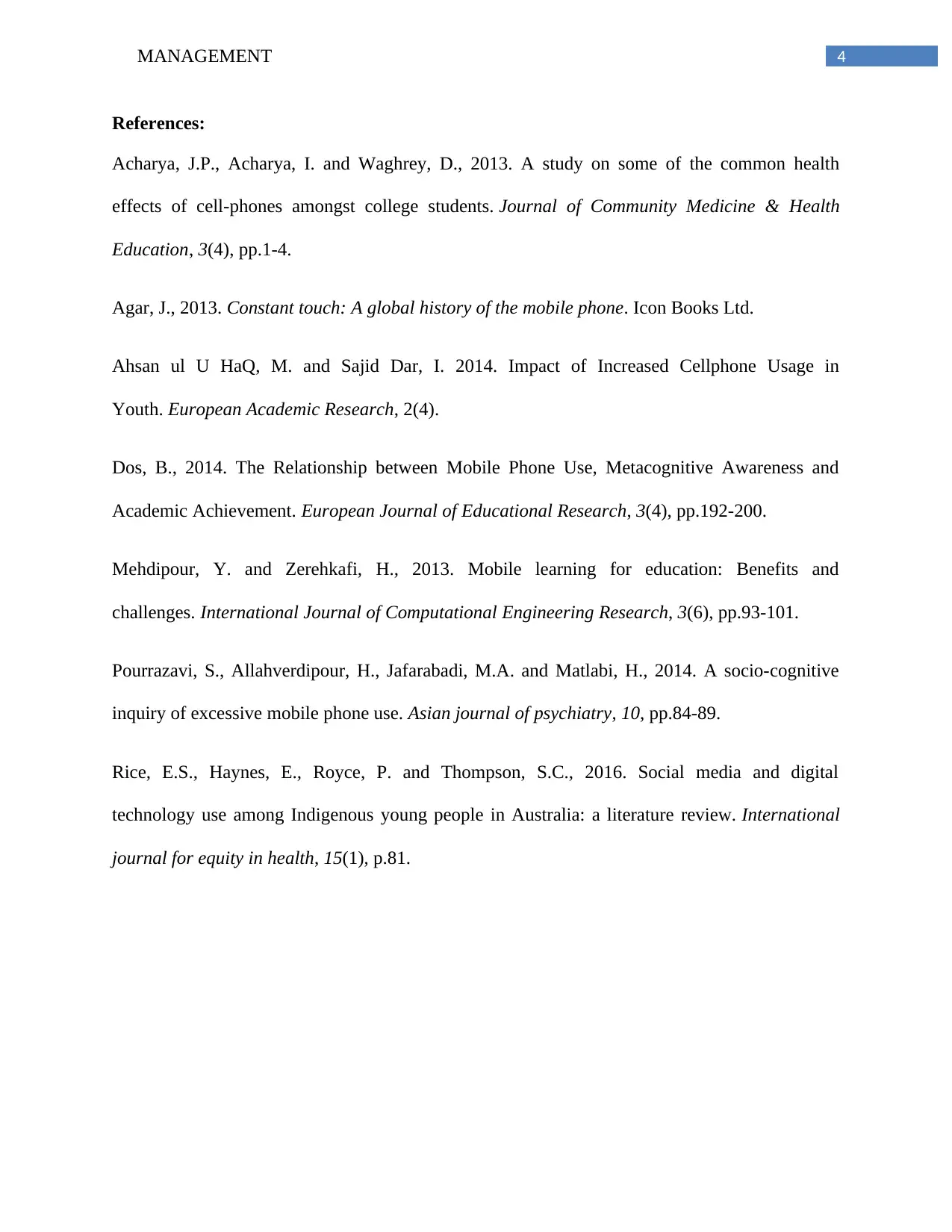
4MANAGEMENT
References:
Acharya, J.P., Acharya, I. and Waghrey, D., 2013. A study on some of the common health
effects of cell-phones amongst college students. Journal of Community Medicine & Health
Education, 3(4), pp.1-4.
Agar, J., 2013. Constant touch: A global history of the mobile phone. Icon Books Ltd.
Ahsan ul U HaQ, M. and Sajid Dar, I. 2014. Impact of Increased Cellphone Usage in
Youth. European Academic Research, 2(4).
Dos, B., 2014. The Relationship between Mobile Phone Use, Metacognitive Awareness and
Academic Achievement. European Journal of Educational Research, 3(4), pp.192-200.
Mehdipour, Y. and Zerehkafi, H., 2013. Mobile learning for education: Benefits and
challenges. International Journal of Computational Engineering Research, 3(6), pp.93-101.
Pourrazavi, S., Allahverdipour, H., Jafarabadi, M.A. and Matlabi, H., 2014. A socio-cognitive
inquiry of excessive mobile phone use. Asian journal of psychiatry, 10, pp.84-89.
Rice, E.S., Haynes, E., Royce, P. and Thompson, S.C., 2016. Social media and digital
technology use among Indigenous young people in Australia: a literature review. International
journal for equity in health, 15(1), p.81.
References:
Acharya, J.P., Acharya, I. and Waghrey, D., 2013. A study on some of the common health
effects of cell-phones amongst college students. Journal of Community Medicine & Health
Education, 3(4), pp.1-4.
Agar, J., 2013. Constant touch: A global history of the mobile phone. Icon Books Ltd.
Ahsan ul U HaQ, M. and Sajid Dar, I. 2014. Impact of Increased Cellphone Usage in
Youth. European Academic Research, 2(4).
Dos, B., 2014. The Relationship between Mobile Phone Use, Metacognitive Awareness and
Academic Achievement. European Journal of Educational Research, 3(4), pp.192-200.
Mehdipour, Y. and Zerehkafi, H., 2013. Mobile learning for education: Benefits and
challenges. International Journal of Computational Engineering Research, 3(6), pp.93-101.
Pourrazavi, S., Allahverdipour, H., Jafarabadi, M.A. and Matlabi, H., 2014. A socio-cognitive
inquiry of excessive mobile phone use. Asian journal of psychiatry, 10, pp.84-89.
Rice, E.S., Haynes, E., Royce, P. and Thompson, S.C., 2016. Social media and digital
technology use among Indigenous young people in Australia: a literature review. International
journal for equity in health, 15(1), p.81.
1 out of 5
Related Documents
Your All-in-One AI-Powered Toolkit for Academic Success.
+13062052269
info@desklib.com
Available 24*7 on WhatsApp / Email
![[object Object]](/_next/static/media/star-bottom.7253800d.svg)
Unlock your academic potential
Copyright © 2020–2025 A2Z Services. All Rights Reserved. Developed and managed by ZUCOL.





